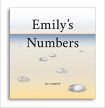Emily's Numbers by Joss Langford
| Emily's Numbers by Joss Langford | |
|
| |
| Category: Children's Non-Fiction | |
| Reviewer: Sue Magee | |
| Summary: A book to enchant the child who is confident with numbers and who is open to discovering some of the magic which is to be found ihn the deep patterns of numbers. Recommended. | |
| Buy? Yes | Borrow? Yes |
| Pages: 32 | Date: February 2018 |
| Publisher: Arch Interface | |
| External links: Author's website | |
| ISBN: 9781999947507 | |
|
| |
Emily found words useful, but counting was what she loved best. Obviously, you can count anything and there's no limit to how far you can go, but then Emily moved a step further and began counting in twos. She knew all about odd and even numbers. Then she began counting in threes: half of the list were even numbers, but the other half were odd and it was this list of odd numbers which occured when you counted in threes which she called threeven. (Actually, this confused me a little bit at first as they're a subset of the odd numbers but sound as though they ought to be a subset of the even numbers, but it all worked out well when I really thought about it.)
When you count in fours the numbers are not very interesting, as they're all even numbers. Emily was disappointed but then she tried counting in fives and developed a list of numbers which occured when you counted in fives but weren't even and didn't appear in the threeven list. These numbers she called fiven. She made a pie chart: half of it contained all the even numbers but the other side was divided into oddish numbers (those which she hadn't yet moved into one of the subsets), threeven and fiven.
She knew that there was no point in bothering with the even numbers, so she made new lists called seven'n and eleven'n - she'd realised too that all of the list counting in nines would be in the threeven list. Half of her pie chart still held the even numbers but the other side was being divided into progressively smaller slices. She discovered something else too: each of her lists began with a prime number. Emily did quite a few other things with her lists including working out how big a fraction of the pie chart each list was and how the numbers neatly divided into columns, but this wasn't just playing - she learned rather a lot about prime numbers.
As a child I struggled with maths: it wasn't that I was disinterested as I thought that numbers were magical, but apparently this was Not Taking The Subject Seriously as it Wasn't There To Be Enjoyed. I do so wish that I'd met Joss Langford and been able to share his love of prime numbers: just reading this delightful little book opened up lots of areas for thought. It isn't simple: you've got to get your brain into gear and get the engine going, but it's so rewarding when you realise how much there is to smile about.
I don't often point out what a book isn't but I think it's important here: this isn't a book for the child who's just learning about numbers as it would just confuse. It's for the older child who is confident with numbers and who has a willingness to explore, who senses the magic. There's plenty of exercise in addition, subtraction, multiplication and prime numbers (and all the work-a-day functions which we have to learn) but they all happen in the course of doing something fun. If you'd like to find out more then have a look at Emily's blog.
I'd like to thank the publisher for sending a copy to the Bookbag.
Children who enjoy this book are likely to go on to enjoy Professor Stewart's Hoard of Mathematical Treasures. You could shelve this next to Count on Me by Miguel Tanco.
Please share on: ![]() Facebook,
Facebook, ![]() Twitter and
Twitter and
![]() Instagram
Instagram
![]() You can read more book reviews or buy Emily's Numbers by Joss Langford at Amazon.co.uk Amazon currently charges £2.99 for standard delivery for orders under £20, over which delivery is free. (Paid link)
You can read more book reviews or buy Emily's Numbers by Joss Langford at Amazon.co.uk Amazon currently charges £2.99 for standard delivery for orders under £20, over which delivery is free. (Paid link)
![]() You can read more book reviews or buy Emily's Numbers by Joss Langford at Amazon.com. (Paid link)
You can read more book reviews or buy Emily's Numbers by Joss Langford at Amazon.com. (Paid link)
Comments
Like to comment on this review?
Just send us an email and we'll put the best up on the site.


